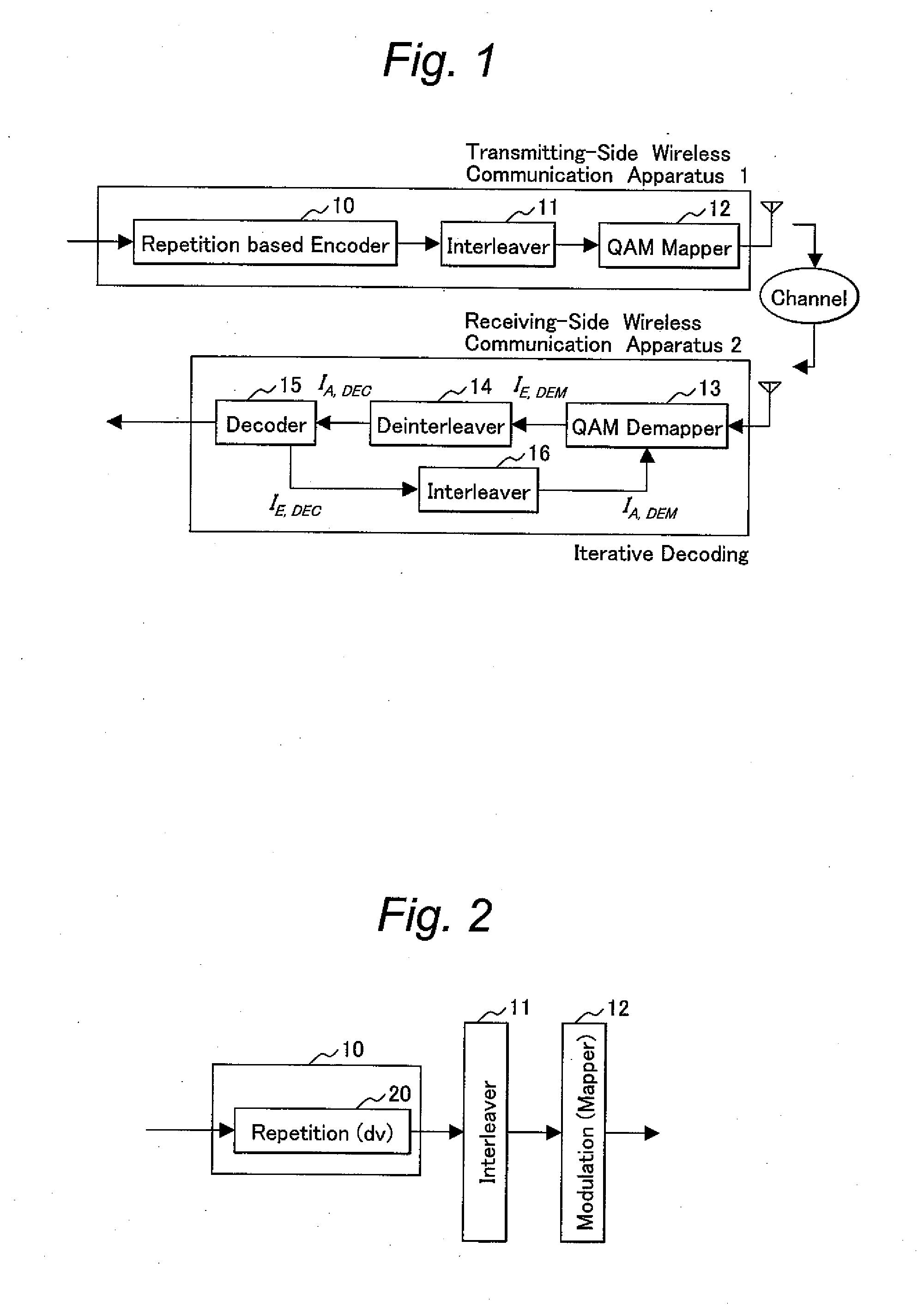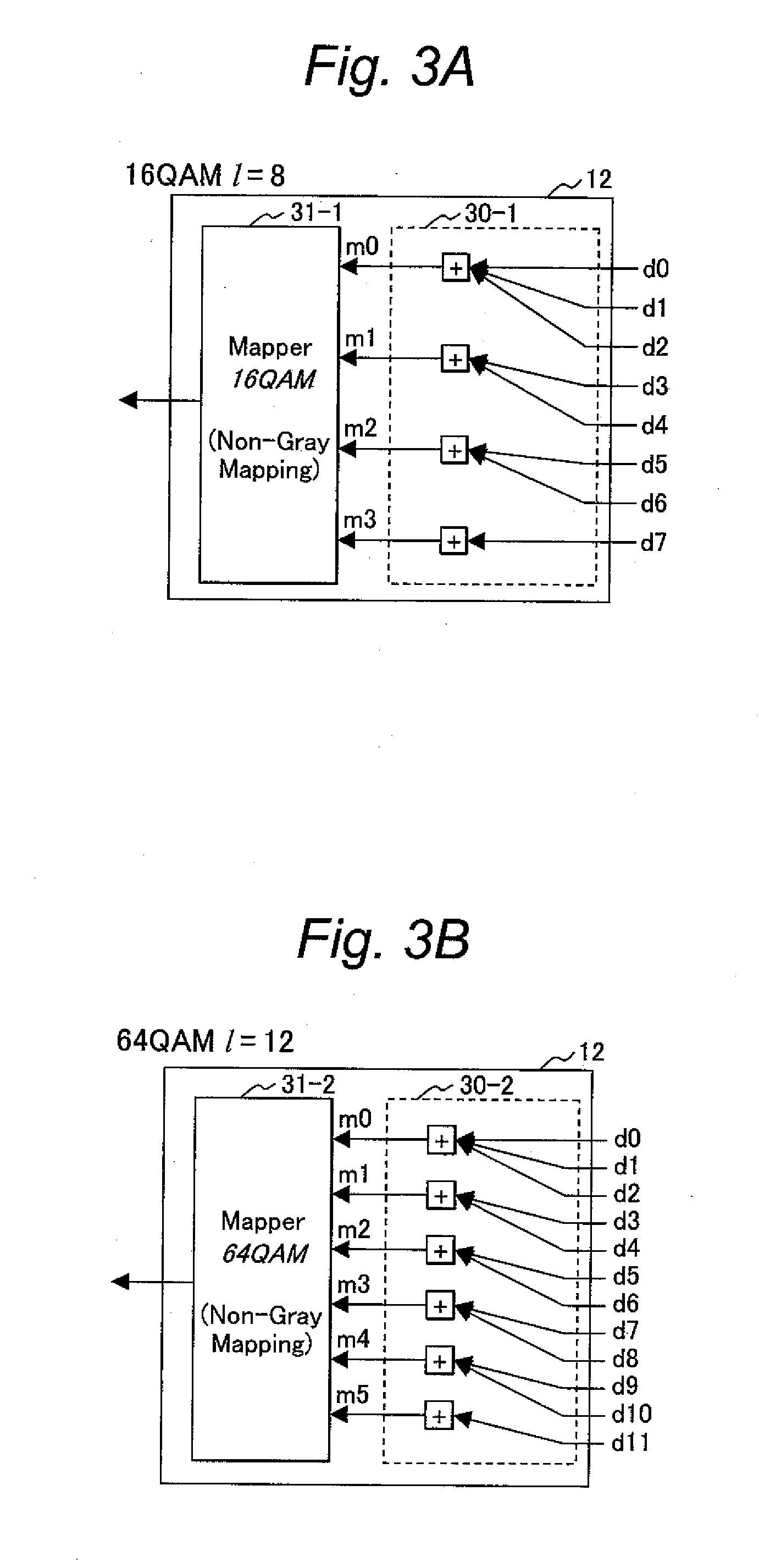Encoding and modulating method, and decoding method for wireless communication apparatus
a wireless communication and modulation technology, applied in the field of encoding and modulation methods, decoding methods for wireless communication apparatus, can solve problems such as ineffective bi-id techniques, and achieve the effects of reducing the loss of transmission speed, reducing processing quantity to be treated by a decoder, and minimizing extended mapping
- Summary
- Abstract
- Description
- Claims
- Application Information
AI Technical Summary
Benefits of technology
Problems solved by technology
Method used
Image
Examples
first embodiment
[0053]FIG. 2 shows the configuration of transmitting-side wireless communication apparatus in accordance with the first embodiment. The encoder 10 includes a bit duplicator 20 that performs simple iterative processing alone. Inputted information bits are duplicated into dv bits, and transmitted via the interleaver 11 and modulator 12.
[0054]FIG. 3A to FIG. 3C show examples of the configuration of the modulator (mapper) 12. The modulator 12 shown in FIG. 3A to FIG. 3C is an example of a modulator that performs extended mapping. FIG. 3A shows an example in which an 8-bit code word is mapped into a symbol representing any of sixteen constellations (16 QAM (1=8)). FIG. 3B shows an example in which a 12-bit code word is mapped into a symbol representing any of sixty-four constellations (64 QAM (1=12)). FIG. 3C shows an example in which a 16-bit code word is mapped into a symbol representing any of 256 constellations (256 QAM (1=16)). In the examples, the modulator 12 includes a bit thinni...
second embodiment
[0079]Next, a second embodiment will be described below. In the second embodiment, an iterative code is used for encoding. However, in the first embodiment, all information bits are encoded iteratively dv times. In contrast, as shown in FIG. 14, bit duplicators 20-1 to 20-n for which different numbers of times of iteration are designated are used at a predetermined ratio (a_1, a_2, etc., and a_n). EXIT curves concerning iterative codes specifying the different number of times of iteration have different shapes. The larger the number of times of iteration is, the downward convexity becomes outstanding. Therefore, when the multiple numbers of times of iteration are used in combination, the freedom in determining the shape of the EXIT curve is expanded. The EXIT curve that well matches a modulation technique can be realized. Decoding processing employed in the second embodiment is, as shown in FIG. 15, nearly identical to that shown in FIG. 7 and employed in the first embodiment. A dif...
third embodiment
[0080]Next, a third embodiment will be described below. In the third embodiment, a parity bit is added prior to encoding to be performed according to an iterative code. As shown in FIG. 16, in the encoder 10, a parity appending block 1600 that produces a parity bit from (dc−1) information bits and outputs dc bits which include information bits is disposed in a stage preceding the bit duplicator 20 that performs iterative encoding. The parity appending block 1600 includes serial-parallel converters (21 and 23) for bits and an exclusive OR gate 22. Decoding processing employed in the third embodiment is, as shown in FIG. 17, achieved by connecting a check-node decoder, which computes a parity bit, to a variable-node decoder. As a decoding procedure, pieces of processing shown in any of FIG. 18A to FIG. 18C are substituted for those shown in FIG. 11.
[0081]In FIG. 18A, pieces of a priori information 1800 fed from the deinterleaver 14 are subjected to the computation expressed by the equ...
PUM
 Login to View More
Login to View More Abstract
Description
Claims
Application Information
 Login to View More
Login to View More - R&D
- Intellectual Property
- Life Sciences
- Materials
- Tech Scout
- Unparalleled Data Quality
- Higher Quality Content
- 60% Fewer Hallucinations
Browse by: Latest US Patents, China's latest patents, Technical Efficacy Thesaurus, Application Domain, Technology Topic, Popular Technical Reports.
© 2025 PatSnap. All rights reserved.Legal|Privacy policy|Modern Slavery Act Transparency Statement|Sitemap|About US| Contact US: help@patsnap.com



